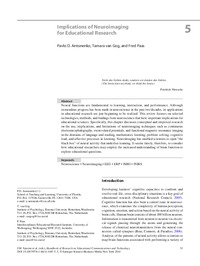Implications of Neuroimaging for Educational ResearchPavlo D. Antonenko, Tamara van Gog, Fred Paas
Zu finden in: Handbook of Research on Educational Communications and Technology (Seite 51 bis 63), 2014
|
 |
 Diese Seite wurde seit 2 Jahren inhaltlich nicht mehr aktualisiert.
Unter Umständen ist sie nicht mehr aktuell.
Diese Seite wurde seit 2 Jahren inhaltlich nicht mehr aktualisiert.
Unter Umständen ist sie nicht mehr aktuell.
 Zusammenfassungen
Zusammenfassungen
 Neural functions are fundamental to learning, instruction, and performance. Although tremendous progress has been made in neuroscience in the past two decades, its applications in educational research are just beginning to be realized. This review focuses on selected technologies, methods, and findings from neuroscience that have important implications for educational sciences. Specifically, this chapter discusses conceptual and empirical research on the use, implications, and limitations of neuroimaging techniques such as continuous electroencephalography, event-related potentials, and functional magnetic resonance imaging in the domains of language and reading, mathematics learning, problem solving, cognitive load, and affective processes in learning. Neuroimaging has enabled scientists to open 'the black box†of neural activity that underlies learning. It seems timely, therefore, to consider how educational researchers may employ the increased understanding of brain function to explore educational questions.
Neural functions are fundamental to learning, instruction, and performance. Although tremendous progress has been made in neuroscience in the past two decades, its applications in educational research are just beginning to be realized. This review focuses on selected technologies, methods, and findings from neuroscience that have important implications for educational sciences. Specifically, this chapter discusses conceptual and empirical research on the use, implications, and limitations of neuroimaging techniques such as continuous electroencephalography, event-related potentials, and functional magnetic resonance imaging in the domains of language and reading, mathematics learning, problem solving, cognitive load, and affective processes in learning. Neuroimaging has enabled scientists to open 'the black box†of neural activity that underlies learning. It seems timely, therefore, to consider how educational researchers may employ the increased understanding of brain function to explore educational questions. Dieses Kapitel erwähnt ...
Dieses Kapitel erwähnt ...
 Fragen KB IB clear | Welche Konsequenzen haben die Erkenntnisse der modernen Hirnforschung für die Schule? |
 Begriffe KB IB clear | cognitive load theory (CLT) |
 Anderswo finden
Anderswo finden
 Volltext dieses Dokuments
Volltext dieses Dokuments
 |  Implications of Neuroimaging for Educational Research: Artikel als Volltext bei Springerlink ( Implications of Neuroimaging for Educational Research: Artikel als Volltext bei Springerlink ( : :  , 477 kByte; , 477 kByte;  : :  2020-11-28) 2020-11-28) |
 Anderswo suchen
Anderswo suchen 
 Beat und dieses Kapitel
Beat und dieses Kapitel
Beat hat Dieses Kapitel während seiner Zeit am Institut für Medien und Schule (IMS) ins Biblionetz aufgenommen. Beat besitzt kein physisches, aber ein digitales Exemplar. Eine digitale Version ist auf dem Internet verfügbar (s.o.). Aufgrund der wenigen Einträge im Biblionetz scheint er es nicht wirklich gelesen zu haben. Es gibt bisher auch nur wenige Objekte im Biblionetz, die dieses Werk zitieren.









 Biblionetz-History
Biblionetz-History